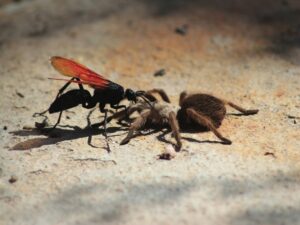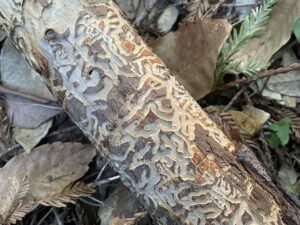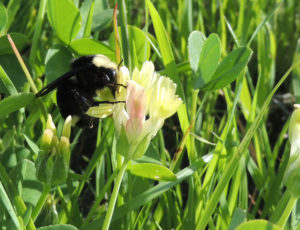
In arid, chamise-filled canyons in eastern Alameda County lives a small, mottled-gray walking stick with an unusual claim to fame: it hasn’t had sex in about a million years. Most insects reproduce sexually, with half their genetic information coming from the mother and half from the father. But a million years ago, Timema genevievae abandoned sex and began to reproduce by cloning itself. T. genevievae and a few other members of its genus have reproduced asexually longer than any other known insects, and as such they help scientists understand the paradox of sex: Why, despite the great risk, time, and effort involved, sex is the prevailing reproductive strategy among multicellular life forms.
T. genevievae is one of two Timema species that live in the East Bay—the other is T. californicum. Both species hatch, mature, and breed over the course of spring and summer, and both belong to the family Timematidae, the earliest branch to diverge from the lineage that led to all other walking sticks. Much like lemurs have taught us a lot about the evolution of other primates, members of the genus Timema have taught us much about the age and origin of important traits in walking sticks, including reproductive behaviors, camouflage, and winglessness. Timema have helped to confirm that winglessness is an ancestral condition for walking sticks. All flying walking sticks have apparently re-evolved their wings.
Gray, brown, and green in color, Timema are notoriously hard to spot, because they look exactly like twigs. They remain still during the day, disguised among the stems and leaves of common chaparral shrubs and trees. In the evening, they emerge from their hiding places to feed. T. genevievae is gray in color, has a dashed light-colored line down its back and an even distribution of light-colored spots over its body, as if spattered with paint. This coloration helps it hide on its primary host plant, chamise. T. californicum is also camouflaged, but because it can live on multiple plants—oak, ceanothus, manzanita, mountain mahogany, and toyon/California holly—populations of T. californicum vary in appearance depending on where they feed. Individuals found on oak and ceanothus are light green with tiny white spots and a white stripe along their sides, while those that feed on toyon, manzanita, or mountain mahogany are sometimes beige or sunset red.
Males of the sexually reproducing Timema californicum are much smaller than females. The size difference facilitates a behavior called mate-guarding. After the male has mated with a female, he clings to her back for up to five days, blocking access by other males and ensuring that he sires more offspring with the female.
T. genevievae, on the other hand, is an exclusively female lineage, one of just five out of 21 Timema species that have abandoned sexual reproduction. It has maintained a self-cloning reproductive strategy for longer than scientists predict it could have survived as a species.
Clonal reproduction presents certain advantages. You can reproduce much more quickly when you don’t have to spend time searching for mates, for example. But it can also have major drawbacks. Without the recombination of genes that occurs with sexual reproduction, clonally reproducing species can more quickly acquire dangerous mutations. They also respond to new evolutionary challenges more slowly. Thus, part of the mystery of T. genevievae is how it has managed to persist for so long without the intergenerational variation created by sexual reproduction. One possible explanation is that the original population was so diverse that clonal reproduction didn’t pose a threat; the population already had enough genetic variation to copy itself for a million years without running into trouble.
Although T. californicum and genevievae differ in their reproductive strategy, they share similar egg-laying habits. Many other walking sticks employ a seemingly carefree method: they scatter their hardened eggs as they feed and move about their host plants, leaving the ova where they fall.
In contrast, female Timema carefully bury their soft eggs in the ground using their cerci, appendages at the end of their abdomens. They also cover the eggs in partially digested soil, a gift of maternal microbes for the next generation. When the nymphs consume the soil, their moms’ microbes populate their guts. That microbial community, or microbiota, helps the insects digest their food and deal with any toxic compounds produced by the plants. In experiments, nymphs fail to develop if they are deprived of this inoculum. It may also ward off parasites, prevent the eggs from desiccating, and protect them from fire.
In the spring, the nymphs emerge, consume their mother’s microbial gift, and populate the East Bay chaparral. Each night, as the moon shines over the hills, they leave their camouflaged hiding places and feed.




